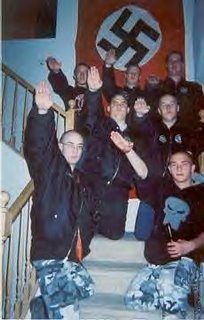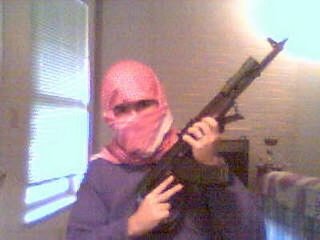Psychopathology of Hate Groups

"According to a report published in 2003 in the FBI Law Enforcement bulletin, a hate group, if unimpeded, pass through seven successive stages of hate. In the first four stages, hate groups vocalize their beliefs and in the last three stages, they act on their beliefs. They point to a transition period that exists between verbal violence and acting that violence out, separating hard-core haters from rhetorical haters."
FBI Law Enforcement Bulletin/March 1, 2003 By John R. Schafer, MA and Joe Navarro, MA
(With comments by Anthony)
Stage 1: Grouping

Haters feel compelled to have others hate as they do. Through peer validation, they get a sense of self-worth and at the same time prevent introspection. Individuals that otherwise would be inefficient, become empowered when they form or join groups. In addition, groups provide a welcome anonymity in which to express their hate without being held accountable.
(Though by definition, gangs are not considered "hate groups", many of the same "brainwashing" / "groupthink" processes take place. Peer validation is a key element in gang related violence. -Anthony)
Stage 2: Self-definition

Hate groups create identities through symbols, mythologies, and rituals, designed to enhance the members' status and at the same time, degrade the object of their hate.
(Self-definition is a key characteristic of most gangs. The use of religious based symbols, gang folklore and legends, and gang rituals all fall into this stage. This is one of the key similarities between the gang mindset, hate group mindset, and the more extensive ideology of terrorist groups. -Anthony)
Stage 3: Disparaging the target
By verbally debasing the object of their hate, haters enhance their self-image, as well as their group status. Researchers have found that the more often a person thinks about aggression, the greater the chance for aggressive behavior to occur. Thus, after constant verbal denigration, haters progress to the next stage.
(Gangs are noted for "disrespecting" opposing gangs. The use of slang terms such as "slob" or "crab" and many others is common with gangs. In fact all gangs use derogatory terms to dehumanize their rivals. This is most often seen in gang related graffiti. This kind of "disparaging" is also seen in all groups engaged in "war" with a rival. -Anthony)
Stage 4: Taunting the target
Time cools the fire of hate forcing the hater to look inward. To avoid introspection, haters increase their use their rhetoric and violence to maintain high levels of agitation. Taunts and offensive gestures serve this purpose.
(Disrespecting a gang rival is often a catalyst for a gang war. Whether that disrespect comes in graffiti, a hand sign, or verbally this is a common tactic with gangs. As it is with other dev-groups. -Anthony)

Stage 5: Attacking without weapons
This stage is critical because it differentiates vocally abusive haters from physically abusive ones. Violence coalesces hate groups and isolates them from mainstream society. The element of thrill-seeking appears in this stage. The adrenaline "high" intoxicates the attackers. Each successive hate derived thought or action triggers a more violent response than the one that originally initiated the sequence. Anger builds on anger. Adrenaline-high combined with hate becomes a deadly combination.
(How many gang shootings begin as fist fights, pushes and shoves, or other forms of physical aggression beforehand? This element builds on and is often the result of disrespect using graffiti, hand signs, or verbal taunts. -Anthony)
Stage 6: Attacking with weapons

Some attackers use firearms to commit hate crimes, while others prefer close-contact weapons. Requiring the attacker to be close to the victim, shows the personal-anger aspects of hate. Some attackers choose to discharge firearms at a distance, thus avoiding personal contact. Personal contact empowers and fulfills the deep-seated need of the hater to have dominance over the object of their hate.
(Drive-by shootings are less personal and easier in the psyche of the attacker to commit. Up close and personal killings or attacks with knives and impact weapons often indicate a more "personal" hate and generally take some conditioning to get to this point...with the exception of the individuals in the population who actually enjoy inflicting physical violence on others without empathy. -Anthony)
Stage 7: Destroying the target

The ultimate goal of haters is to destroy the object of their hate. With the power over life and death comes a great sense of self-worth and value, the very qualities haters lack, however, the ultimate destiny of hate is the physically and psychologically destruction of both the hater and the hated.
(Gang killings and other dev-group murders are the end result of a process. This process has been illustrated here. Intervention in this process is critical to stopping active violence before it reaches this critical point. -Anthony)



<< Home